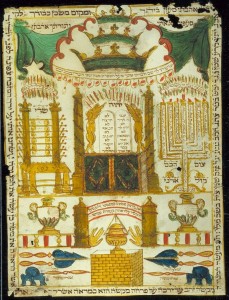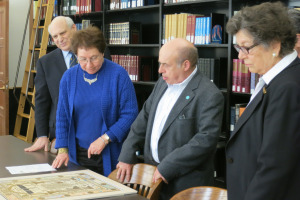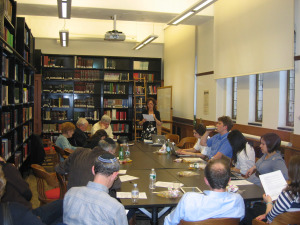 We are happy to announce that the Yale community now has full access to Haaretz Daily News, one of Israel’s premier news outlets.
We are happy to announce that the Yale community now has full access to Haaretz Daily News, one of Israel’s premier news outlets.
English- http://www.haaretz.com/
Hebrew- http://www.haaretz.co.il/

 Shiviti plaque : Herat, Afghanistan, early 20th century?
Shiviti plaque : Herat, Afghanistan, early 20th century?
Such plaques were hung in the synagogue to inspire more devout prayer.
Physical Description: 1 item ([1] leaf) ; approximately 60 x 48 cm In Hebrew.
Summary: Manuscript, ink and paint? on paper. God’s name is written in large letters at the top of the document and two turquoise fish appear among the letters. They may be there as symbols of fertility. Throughout the Shiviti are words with that have magic and folk kabbalistic significance. The shiviti includes five seven-branched candelabra formed from calligraphic texts of psalms. In between the bases of the candelabra are four six-pointed stars formed by Hebrew letters that seem to have magical meanings. The text on the outer border quotes Jacob’s blessing of Joseph in the Book of Genesis. There is some damage to the text at the bottom. The plaque is dedicated to the memory of Netanel bar Mosheh, but the identity of the scribe is unknown since only his initials are given.
Louis Mayer Rabinowitz became Yale’s great friend and benefactor as a result of a visit to the university in 1943 when he presented to the Yale library a recording of speeches by Wendell Willkie, Al Smith and others. Until then, his main interest was art collecting but librarians at Yale and particularly James T. Babb, the University Library, encouraged him also to buy books and manuscripts. From there on in, he became an avid collector, and his extraordinary gifts to the Library helped make Yale a major player in the world of rare books and manuscripts.
Louis M. Rabinowitz’s life story represents the classic American dream. He was born in Lithuania and he arrived in this country as a penniless immigrant at the age of 14. As a young boy, he sold remnants of fabric from a pushcart on Hester Street, and then became a house painter’s helper. He went on to make a fortune in the manufacture of women’s undergarments. Though his formal education ended when he was 12 years old, he became a knowledgeable and cultured man through his own efforts and hard work.
Rabinowitz’s greatest contribution-though by no means his only one-to Judaic studies in the Yale library is the Judaica collection of the Yiddish writer,Sholem Asch. He purchased Asch’s collection in 1945 and presented it to the University. Yale also received with the gift several manuscripts of Asch’s own writings. The Rabinowitz/Asch Collection, as it came to be called, contained about 330 items of incunabula (books printed before 1500), 16th century imprints, first editions of important rabbinic works, magnificent illuminated ketubot (marriage contracts) and megilot (Scrolls of Esther) from Italy, and early editions of important works in Yiddish. Among the ketubot are several from the 18th and early 19th centuries from the Modigliani family. All are from Rome though the famous painter, Amadeo Modigliani, belonged to the branch of the family that resided in Livorno.

Keter (crown)
Place and date unknown
Symbolic representation of the three crowns: learning, priesthood, royalty. But surpassing them all is the fourth, the crown of a good name. To your left is a representation of the Tabernacle or the Temple with seven-branched candelabrum, the ark of the law, and the cherubim in the center. The shew-bread is on the left. The hands below represent the priesthood with an incense-holder.
This document, like the one above, was also probably meant to be hung in a synagogue.
Other treasures include a group of illustrated manuscripts built around the statement in Pirke Avot (Ethics of the Fathers) 4:17 that three crowns were given to the Jewish people: the crown of Torah, the crown of priesthood and the crown of kingship. However, the crown of a good name is above them all. Leon Nemoy, Yale’s first curator in charge of Judaica and the curator at the time of the gift, called these documents, ketarim (crowns) because there is no other genre in which to include them. They stand alone as artistic representations of spiritual values and they are among the most beautiful documents in Asch’s collection. Included in the gift are 7 incunabla.
Known in English as cradle books because they were the very first books ever printed, they are needless to say exceedingly rare. Given their age, they are often missing pages or have many damaged pages but they are nevertheless the most desired of books and to receive seven of them at one time was most fortuitous for Yale. Among them is a volume of the latter prophets (Isaiah and Jeremiah only) and a volume of the ketuvim (hagiographa) both printed by Eliezer Toledano in Lisbon in 1492, the year in which the Jews were expelled from Spain and Columbus discovered America. Portugal expelled the Jews in its realm—and that included all the Jews who fled there from Spain—in 1497. The ensuing chaos and destruction meant that most Jewish books printed in Portugal were either lost or destroyed. Those that survived are therefore extremely rare and precious.
Another book that stands out is the Bovo-bukh printed in Amsterdam in 1661 by Uri Phoebus ben Aaron ha-Levi. It is a translation by Elias Levita (1468-1549) in rhymed Yiddish verse of the Italian version of the Buovo d’Antona which is in itself a translation of the early 14th-century Anglo-Norman original, Boeuve de Hanstone. This chivalric romance which tells the story of the heroic adventures of the noble Bovo became one of the most beloved tales in the Yiddish literary canon and remained so over the course of more than two centuries.
In a future blog, I will discuss some of the other treasures that came with the Asch Collection.
 We are happy to announce that the Yale community now has full access to Haaretz Daily News, one of Israel’s premier news outlets.
We are happy to announce that the Yale community now has full access to Haaretz Daily News, one of Israel’s premier news outlets.
English- http://www.haaretz.com/
Hebrew- http://www.haaretz.co.il/
 Natan Sharansky is a prominent Israeli politician, human rights activist and author who spent nine years in a Soviet prison for allegedly spying for the United States. He is one of the heroes of the struggle of Jews to immigrate to Israel during the Soviet era. Sharansky is the author of The Case for Democracy, Fear No Evil and Defending Identity. He is currently chairman of the Executive of the Jewish Agency and was recently in the news in his attempt to resolve the ongoing tensions between fundamentalist Jewish groups and Conservative and Reform women’s groups with regard to the right of women to lead their own services at the Western Wall.
Natan Sharansky is a prominent Israeli politician, human rights activist and author who spent nine years in a Soviet prison for allegedly spying for the United States. He is one of the heroes of the struggle of Jews to immigrate to Israel during the Soviet era. Sharansky is the author of The Case for Democracy, Fear No Evil and Defending Identity. He is currently chairman of the Executive of the Jewish Agency and was recently in the news in his attempt to resolve the ongoing tensions between fundamentalist Jewish groups and Conservative and Reform women’s groups with regard to the right of women to lead their own services at the Western Wall.
The Yale University Library recently had the honor of welcoming him to the Judaica Collection in which Nanette Stahl, Librarian for Judaic Studies, showed him several of the illuminated Hebrew manuscripts she had recently acquired. Joining them are Harvey Goldblatt, Professor of Medieval and Slavic Literature and Chairman of the Slavic Language and Literature Department as well as Master of Pierson College, and Tatjana Lorkovic, Librarian for Slavic Studies.
 On April 10, 2013 the Program in Judaic Studies held its annual colloquium in the Judaic Studies reading room. Two speakers from the Program gave presentations on the research in which they are currently engaged. Eve Krakowski, Hilda & Jacob Blaustein Post-Doctoral Fellow spoke on “Jewish Marriage Choices in Medieval Egypt: Towards an Anthropology of Rabbanite Legal Practice. ” And, Christine Hayes (shown in the photo) the Robert F & Patricia Ross Weis Professor of Religious Studies spoke on “ ‘ In the West, they laughed at him:’ The Babylonian Talmud’s Mocking Realists.” A light dinner was served between the two presentations. The colloquium is an annual event in which both faculty members, post-doctoral fellows and graduate students have an opportunity to talk about their work and receive feed-back from their colleagues.
On April 10, 2013 the Program in Judaic Studies held its annual colloquium in the Judaic Studies reading room. Two speakers from the Program gave presentations on the research in which they are currently engaged. Eve Krakowski, Hilda & Jacob Blaustein Post-Doctoral Fellow spoke on “Jewish Marriage Choices in Medieval Egypt: Towards an Anthropology of Rabbanite Legal Practice. ” And, Christine Hayes (shown in the photo) the Robert F & Patricia Ross Weis Professor of Religious Studies spoke on “ ‘ In the West, they laughed at him:’ The Babylonian Talmud’s Mocking Realists.” A light dinner was served between the two presentations. The colloquium is an annual event in which both faculty members, post-doctoral fellows and graduate students have an opportunity to talk about their work and receive feed-back from their colleagues.